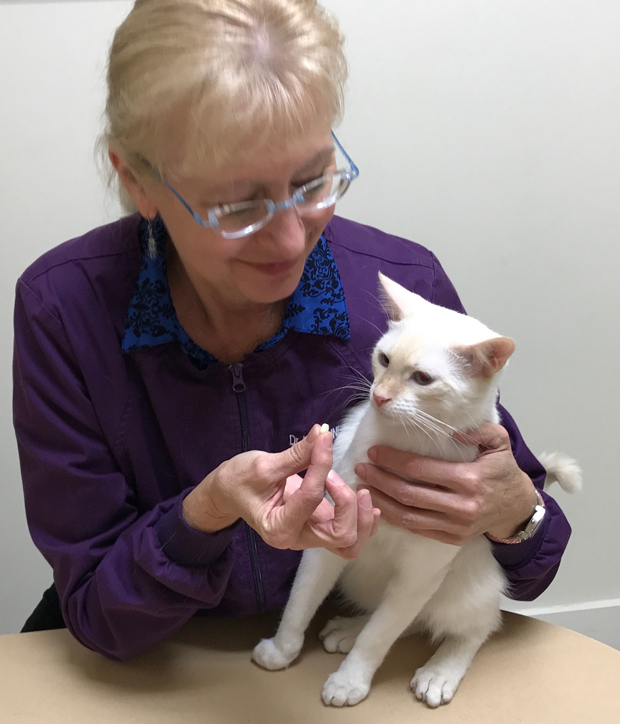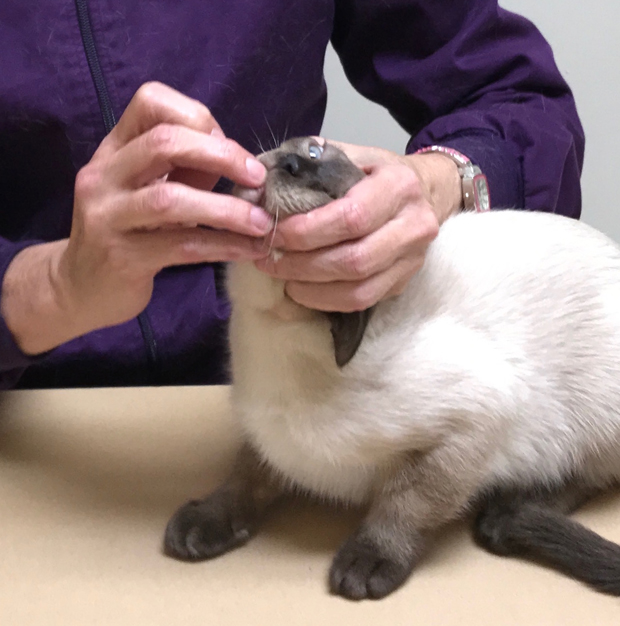
Photos courtesy of Long Beach Animal Hospital
Giving your cat medication, whether oral or liquid, can be quite the challenge, to put it mildly. Being restrained with mouth forced open and noxious substances forced down the throat are not in your cat’s to-do list for the day. It’s easy to understand why this causes anxiety and panic, threatening injury to both you and your cat. There are ways to make giving necessary medications less stressful for all involved.
Conditioning your cat to stressful events beforehand is key to helping him or her relax and return to normal quickly. The use of the cat carrier is helpful for more than just traveling. If it’s part of the normal environment, as we described in “The Traveling Cat: A Tale of Two Kitties,” it becomes a safe and comfortable haven. We can use our foster kittens as an example of preconditioning to help the whole medication process.
Canned food has always been part of their diet, in addition to free-choice dry food. The canned food is something “special” for them—a chance to keep training them to come when called—and they’ve been exposed to several different brands and flavors to avoid creating fussy eaters (this is not foolproof, but it’s sure helpful). They’re also frequently fed in their carriers, which reinforces the feeling of the carrier as a safe place and its attractiveness even more.
When they need medication, it’s mixed in with their canned food. The dose is measured out for each cat and mixed into separate bowls, either in liquid form or by crushing a tablet with the back of a spoon. Each cat is then enclosed in the carrier with the medicated food. They’re not released until they’ve finished their medicated food, but this isn’t greatly stressful because they’ve been through “practice runs” plenty of times, eating their meals closed inside their carriers for various periods of time.
Some cats, of course, aren’t easily fooled, especially if the medication has a strong taste. Adding tuna juice to the food or using a fish-flavored canned food with a strong aroma may help disguise the flavor. If the cats decide they’d rather go without the canned food and settle for dry food only, I remove the dry food, replacing it only after they’ve finished the medicated canned food.
But what if we don’t have a history of conditioning with canned food and the cat will not touch it? We then have to go ahead and administer the medication orally. Proper restraint and a calm attitude go a long way toward making this successful. Some cats do well with a gentle but firm grip on the scruff of the neck, tipping the head up so he or she is looking at the ceiling, and inserting the tip of a dropper into the corner of the mouth.
With a tablet, moistening it a little first helps it go down, again holding the head tipped up so the cat is looking at the ceiling. Avoid letting the head move downward, as it will make everything harder. With the cat’s head cupped in your left hand and the nose pointed upward, apply firm but gentle pressure with your left thumb and middle finger on either side of the mouth.
Use your right thumb to gently pry the lower jaw open. As soon as the mouth opens, squeeze firmly with your left hand on the cheeks to keep the mouth open. With your right fingers, place the moistened tablet straight down into the back of the throat, close the mouth and keep the head pointing upwards—otherwise the cat’s head will go straight down and spit the tablet out. Sometimes, gently blowing on the nose will cause the cat to swallow. When the tongue comes out to lick the lips, it means that the pill has been swallowed. Release the kitty and provide plenty of petting and reassurance.

Most cats are reluctant to take medications.

Steadying his head with the left hand, his lower jaw is gently pried open.

The fingers of the left hand are gently squeezing inward on his cheeks, so he can’t bite down as the pill is deposited in the back of his throat.

Keeping his head up after the pill is administered helps prevent him from spitting it out. Blowing gently on his nose also encourages him to swallow.

Holding firmly but gently until he has swallowed the pill, with his head tilted upwards.

After the pill is done.
If your cat simply will not tolerate this, it’s time for a “burrito wrap.” This involves wrapping the cat snugly in a towel so that only the face is showing. Then, use the suggestions above to get the medication down. If the cat wises up and takes off whenever you come around with a towel, make this scary towel part of everyday life before the burrito wrap is needed. Have the towel available when you play with and pet the cat, sometimes laying it on the body and head and occasionally wrapping the cat up as part of playtime. It’s all about making the unfamiliar familiar and toning down the fear response.
Cats are unique in how they metabolize drugs with their liver and kidneys, so never give them any medication that we have not prescribed. For more information on diseases and what medications might be given to a cat, please visit the Diseases section of our website.

